@
前言
最近新项目中有涉及到微信支付相关接口业务的交互,毕竟原先开发接触过支付这块,轻车熟路。打开微信支付官方文档,好家伙,微信支付API 升级至v3版本了,心中一万匹草泥马奔涌而来,根据以往对微信开发文档的认识,赶紧倒杯水,喝一喝,压压惊。
喝完之后,开启了微信支付API v3的对接之路。
版本
jdk:1.8
wechatpay-apache-httpclient:0.2.2
应用
笔者以微信小程序支付接口为例展开说明,至于小程序注册、认证、微信支付注册本文概不说明。
基础配置
1.申请商户API证书
登录微信支付后台,进入账户中心,API安全设置,如下图

申请商户证书,如下图
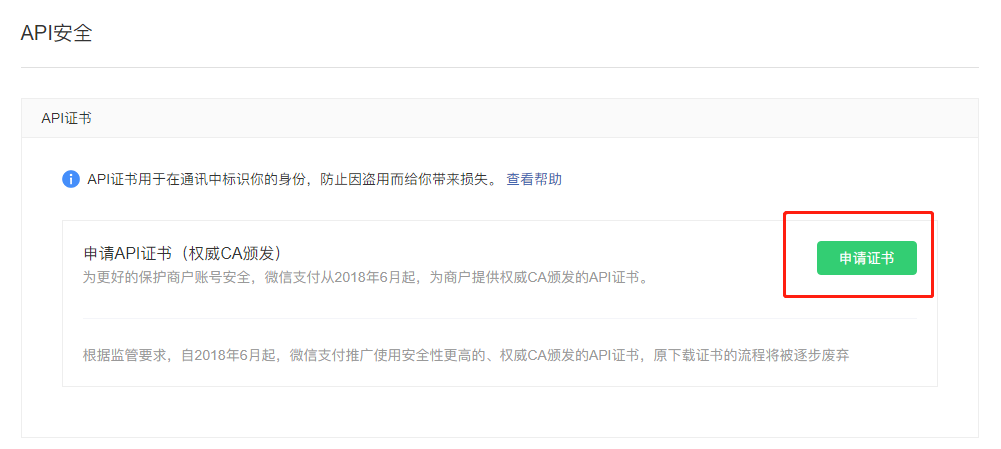
点击“申请证书”按钮后,弹出生成API证书申请框,如下图
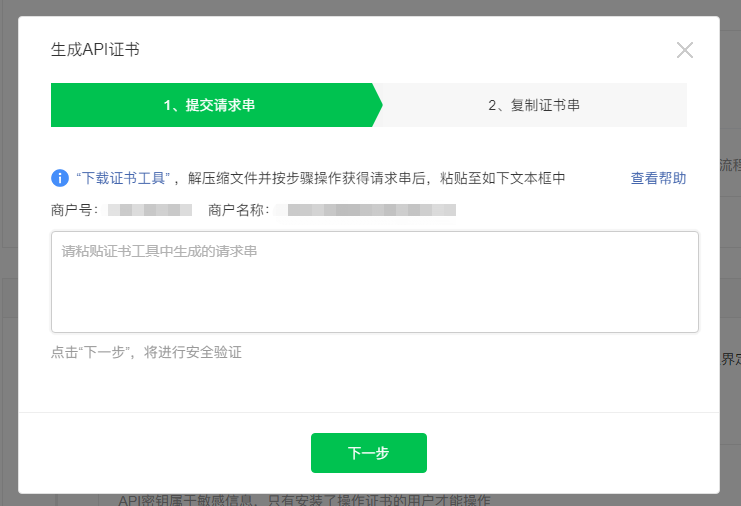
根据提示下载证书工具,当前页面不要关闭,下载证书工具后打开,如下图

点击“申请证书”按钮后,进入填写商户信息界面,商户信息经测试是自动填充的,如下图
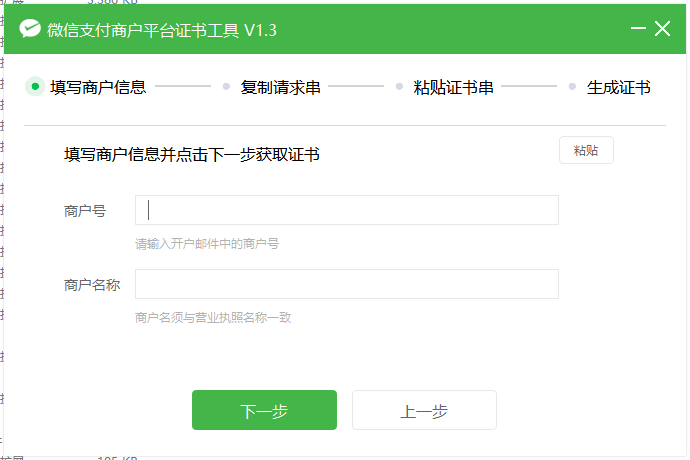
点击“下一步”,进入复制请求串界面,如下图
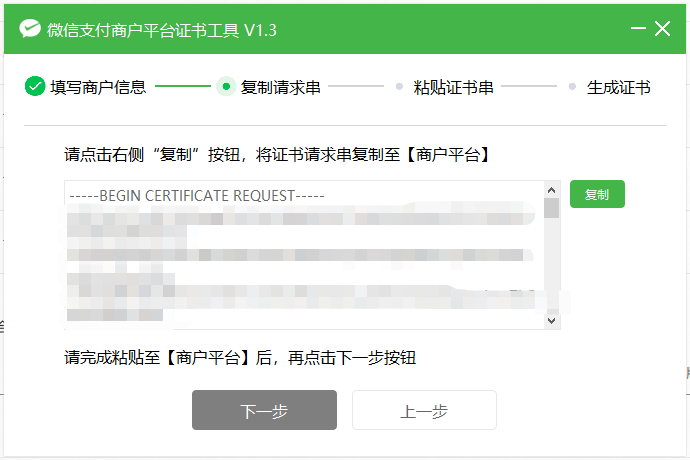
将证书请求串进行复制,复制后回到上述微信支付后台申请API证书页面,将请求串进行复制,经测试自动帮你完成复制粘贴,请求串复制后点击“下一步”操作,进入复制证书串步骤,如下图
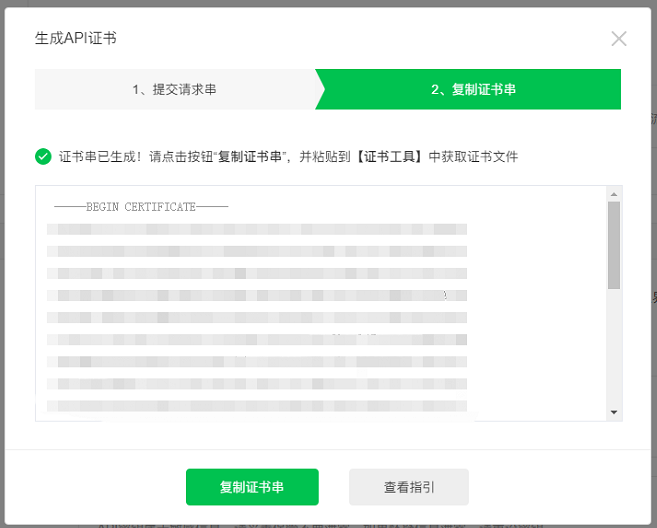
点击“复制证书串”,将复制的证书串粘贴至证书工具中,如下图
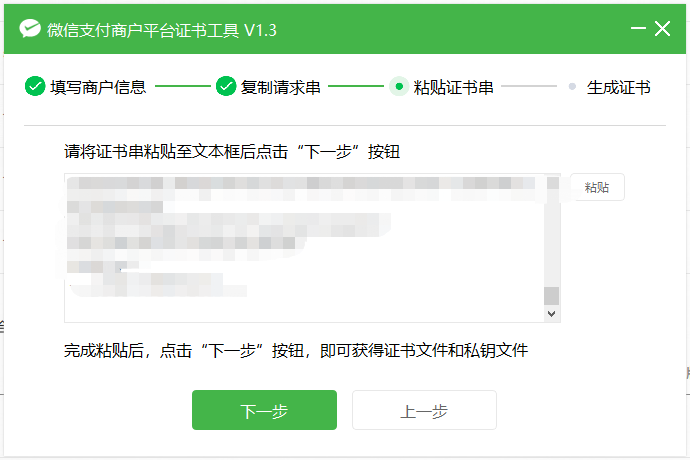
点击“下一步”完成商户证书的申请,如下图
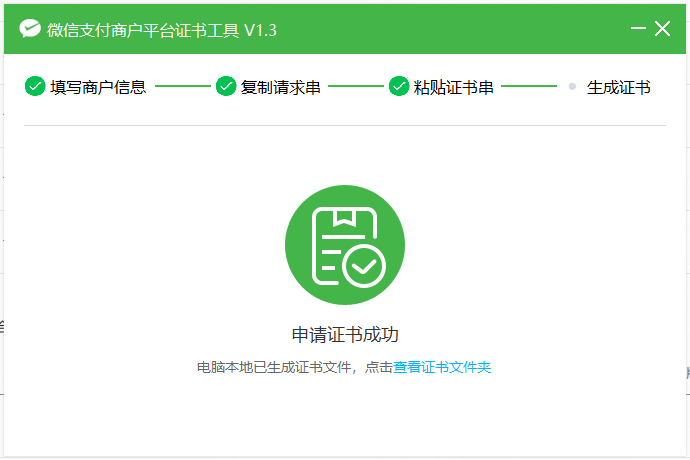
商户API证书已生成,点击查看证书文件夹,即可查看证书信息,如下图

在微信支付商户后台可获取商户API证书序列号及证书有效期,如下图
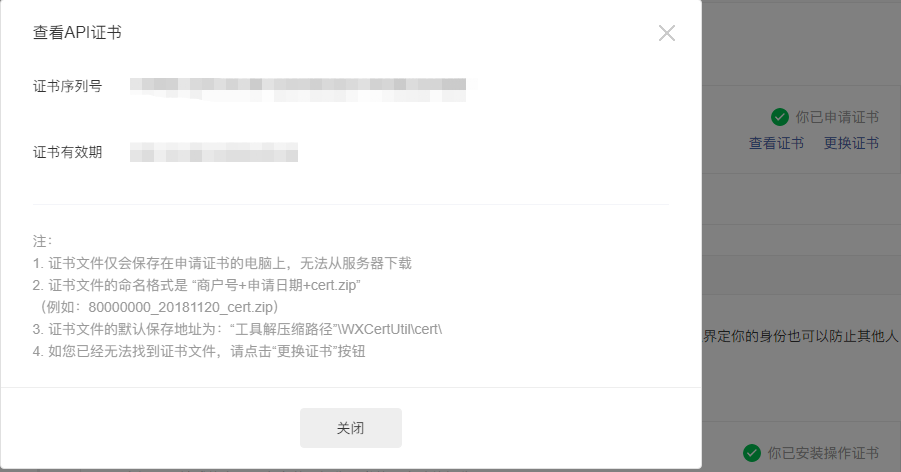
2.设置接口密钥
设置API密钥,现阶段由于微信支付原先老接口并未全部升级至API v3版,涉及新老接口共存的情况,所以API密钥及APIV3密钥都需进行设置,新老接口请查阅微信支付开发文档

API v2老版本密钥设置

API v3密钥设置
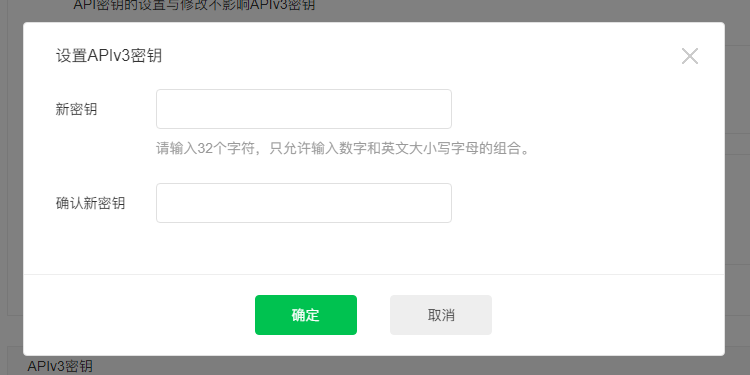
3.下载平台证书
微信平台证书下载,查阅开发文档,微信已提供证书下载工具 如下图
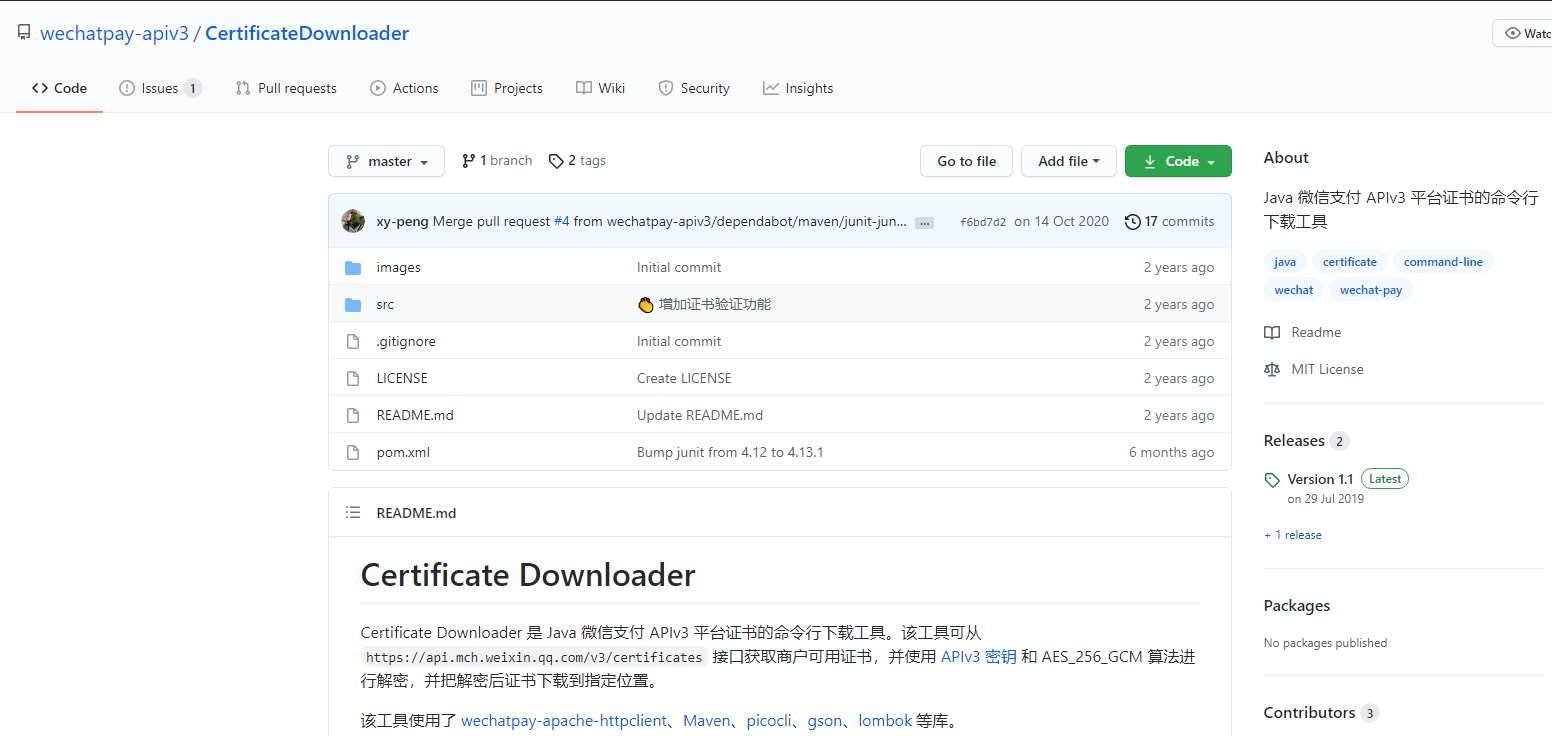
关注本文末尾微信公众号,回复“666”获取常用开发工具包,内含常用开发组件及微信证书下载工具,节省FQ下载时间。
下载平台证书至本地,执行命令
必需参数有:
商户的私钥文件,即 -f (商户API证书中apiclient_key.pem文件路径)
证书解密的密钥,即 -k (微信支付后台设置的APIv3密钥)
商户号,即 -m (微信支付商户号,可在微信支付后台查阅)
保存证书的路径,即 -o (微信平台证书保存路径)
商户证书的序列号,即 -s (商户API证书,即上述第一步申请商户API证书序列号)
非必需参数有:
微信支付证书,用于验签,即 -c
完整命令如下
java -jar CertificateDownloader-1.1.jar -k ${apiV3key} -m ${mchId} -f ${mchPrivateKeyFilePath} -s ${mchSerialNo} -o ${outputFilePath}
至此基础配置参数已准备就绪
接口实测
在请求接口之前先了解下接口中一些参数概念,首次接触最容易搞混的就是商户API证书和平台证书,如下图
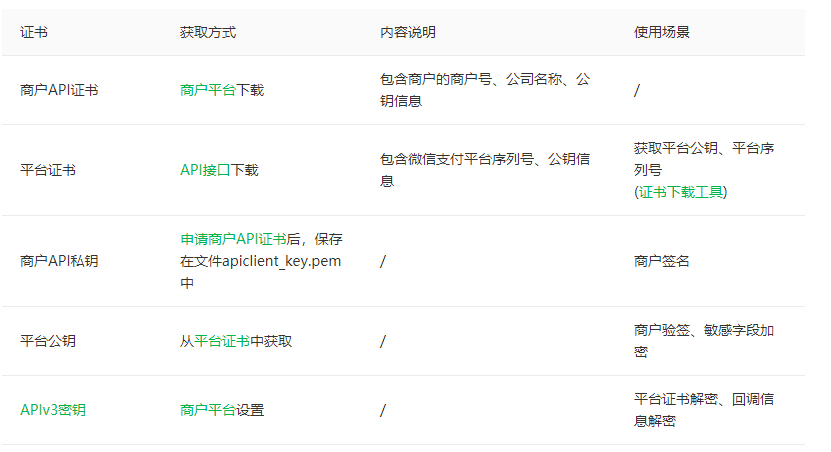
微信支付API官方客户端
以往老吐槽微信支付接口文档不友好,没有sdk,现在API v3版本给你提供了一个客户端,这点还是可以点赞的,对于开发人员来说,demo代码直接拿过来,更改下配置参数就可以跑通,那简直是对程序员莫大的关怀,这方面阿里相对做的比较好
talk is cheap, show me the code
1.客户端
以post请求方式说明,get请求类似
private static String basePostRequest(String requestUrl,String requestJson) {
CloseableHttpClient httpClient = null;
CloseableHttpResponse response = null;
HttpEntity entity = null;
try {
PrivateKey merchantPrivateKey = PemUtil.loadPrivateKey(new ByteArrayInputStream(privateKey.getBytes("utf-8")));
X509Certificate wechatpayCertificate = PemUtil.loadCertificate(new ByteArrayInputStream(certificate.getBytes("utf-8")));
ArrayList<X509Certificate> listCertificates = new ArrayList<>();
listCertificates.add(wechatpayCertificate);
httpClient = WechatPayHttpClientBuilder.create()
.withMerchant(mchId, mchSerialNo, merchantPrivateKey)
.withWechatpay(listCertificates)
.build();
HttpPost httpPost = new HttpPost(requestUrl);
// NOTE: 建议指定charset=utf-8。低于4.4.6版本的HttpCore,不能正确的设置字符集,可能导致签名错误
StringEntity reqEntity = new StringEntity(requestJson, ContentType.create("application/json", "utf-8"));
httpPost.setEntity(reqEntity);
httpPost.addHeader("Accept", "application/json");
response = httpClient.execute(httpPost);
entity = response.getEntity();
return EntityUtils.toString(entity);
} catch (Exception e) {
e.printStackTrace();
} finally {
// 关闭流
}
return null;
}
方法中涉及参数说明
| 参数名 | 说明 |
|---|---|
| privateKey | 商户私钥(商户API证书apiclient_key.pem文件内容) |
| certificate | 平台证书(通过CertificateDownloader下载的证书文件内容) |
| mchId | 微信支付商户号 |
| mchSerialN | 商户API证书序列号 |
PemUtil.java类为com.wechat.pay.contrib.apache.httpclient.util.PemUtil
请求签名及应答签名校验该客户端均已帮你处理好,心中对微信支付开发文档有了一点点好感。根据具体接口方法传入接口地址及相应接口参数JSON数据即可完成接口联调测试。
2.支付调起参数签名
以小程序调起支付接口为例,简单说明参数签名方式,先看下文档中签名是怎么说的,如下图

/**
* 微信支付-前端唤起支付参数
* prepay_id=wx201410272009395522657a690389285100
* @param packageStr 预下单接口返回数据 预支付交易会话标识 prepay_id
* @return
*/
public static Map<String,Object> createPayParams(String packageStr) {
Map<String,Object> resultMap = new HashMap<>();
String nonceStr = StringUtil.getUUID();
Long timestamp = System.currentTimeMillis() / 1000;
String message = buildMessage(timestamp, nonceStr, packageStr);
String signature = null;
try {
signature = sign(message.getBytes("utf-8"));
} catch (UnsupportedEncodingException e) {
e.printStackTrace();
}
resultMap.put("appId", appId);
resultMap.put("timeStamp",timestamp.toString());
resultMap.put("nonceStr",nonceStr);
resultMap.put("package",packageStr);
resultMap.put("signType","RSA");
resultMap.put("paySign",signature);
return resultMap;
}
/**
* 微信支付-前端唤起支付参数-签名
* @param message 签名数据
* @return
*/
public static String sign(byte[] message) {
try{
Signature sign = Signature.getInstance("SHA256withRSA");
sign.initSign(getPrivateKey(keyFilePath));
sign.update(message);
return Base64.getEncoder().encodeToString(sign.sign());
} catch(Exception e) {
e.printStackTrace();
}
return null;
}
/**
* 微信支付-前端唤起支付参数-构建签名参数
* @param nonceStr 签名数据
* @return
*/
public static String buildMessage(long timestamp, String nonceStr, String packageStr) {
return appId + "
"
+ timestamp + "
"
+ nonceStr + "
"
+ packageStr + "
";
}
/**
* 微信支付-前端唤起支付参数-获取商户私钥
*
* @param filename 私钥文件路径 (required)
* @return 私钥对象
*/
public static PrivateKey getPrivateKey(String filename) throws IOException {
String content = new String(Files.readAllBytes(Paths.get(filename)), "utf-8");
try {
String privateKey = content.replace("-----BEGIN PRIVATE KEY-----", "")
.replace("-----END PRIVATE KEY-----", "")
.replaceAll("\s+", "");
KeyFactory kf = KeyFactory.getInstance("RSA");
return kf.generatePrivate(
new PKCS8EncodedKeySpec(Base64.getDecoder().decode(privateKey)));
} catch (NoSuchAlgorithmException e) {
throw new RuntimeException("当前Java环境不支持RSA", e);
} catch (InvalidKeySpecException e) {
throw new RuntimeException("无效的密钥格式");
}
}
方法中涉及参数说明
| 参数名 | 说明 |
|---|---|
| appId | 小程序appid |
| keyFilePath | 商户API证书apiclient_key.pem路径 |
3.回调通知
回调通知涉及验签及解密
回调数据获取
String body = request.getReader().lines().collect(Collectors.joining());
验签
/**
* 回调验签
* https://pay.weixin.qq.com/wiki/doc/apiv3/wechatpay/wechatpay4_1.shtml
* @param wechatpaySerial 回调head头部
* @param wechatpaySignature 回调head头部
* @param wechatpayTimestamp 回调head头部
* @param wechatpayNonce 回调head头部
* @param body 请求数据
* @return
*/
public static boolean responseSignVerify(String wechatpaySerial, String wechatpaySignature, String wechatpayTimestamp, String wechatpayNonce, String body) {
FileInputStream fileInputStream = null;
try {
String signatureStr = buildMessage(wechatpayTimestamp, wechatpayNonce, body);
Signature signer = Signature.getInstance("SHA256withRSA");
fileInputStream = new FileInputStream(weixin_platform_cert_path);
X509Certificate receivedCertificate = loadCertificate(fileInputStream);
signer.initVerify(receivedCertificate);
signer.update(signatureStr.getBytes(StandardCharsets.UTF_8));
return signer.verify(Base64.getDecoder().decode(wechatpaySignature));
} catch (Exception e ) {
e.printStackTrace();
} finally {
if (fileInputStream != null) {
try {
fileInputStream.close();
} catch (IOException e) {
e.printStackTrace();
}
}
}
return false;
}
/**
* 回调验签-加载微信平台证书
* @param inputStream
* @return
*/
public static X509Certificate loadCertificate(InputStream inputStream) {
try {
CertificateFactory cf = CertificateFactory.getInstance("X509");
X509Certificate cert = (X509Certificate) cf.generateCertificate(inputStream);
cert.checkValidity();
return cert;
} catch (CertificateExpiredException e) {
throw new RuntimeException("证书已过期", e);
} catch (CertificateNotYetValidException e) {
throw new RuntimeException("证书尚未生效", e);
} catch (CertificateException e) {
throw new RuntimeException("无效的证书", e);
}
}
/**
* 回调验签-构建签名数据
* @param
* @return
*/
public static String buildMessage(String wechatpayTimestamp, String wechatpayNonce, String body) {
return wechatpayTimestamp + "
"
+ wechatpayNonce + "
"
+ body + "
";
}
方法中涉及参数说明
| 参数名 | 说明 |
|---|---|
| weixin_platform_cert_path | 微信平台证书路径 |
解密
// https://pay.weixin.qq.com/wiki/doc/apiv3/apis/chapter3_1_5.shtml
AesUtil wxAesUtil = new AesUtil(apiv3.getBytes());
String jsonStr = wxAesUtil.decryptToString("associated_data".getBytes(),"nonce".getBytes(),"ciphertext");
方法中涉及参数说明
| 参数名 | 说明 |
|---|---|
| apiv3 | 商户API v3密钥 |
| associated_data | 附加数据 (微信回调通知数据中resource对象) |
| nonce | nonce (微信回调通知数据中resource对象) |
| ciphertext | 数据密文 (微信回调通知数据中resource对象) |
| jsonStr | 对resource对象进行解密后,得到的资源对象数据 |
参考资料
